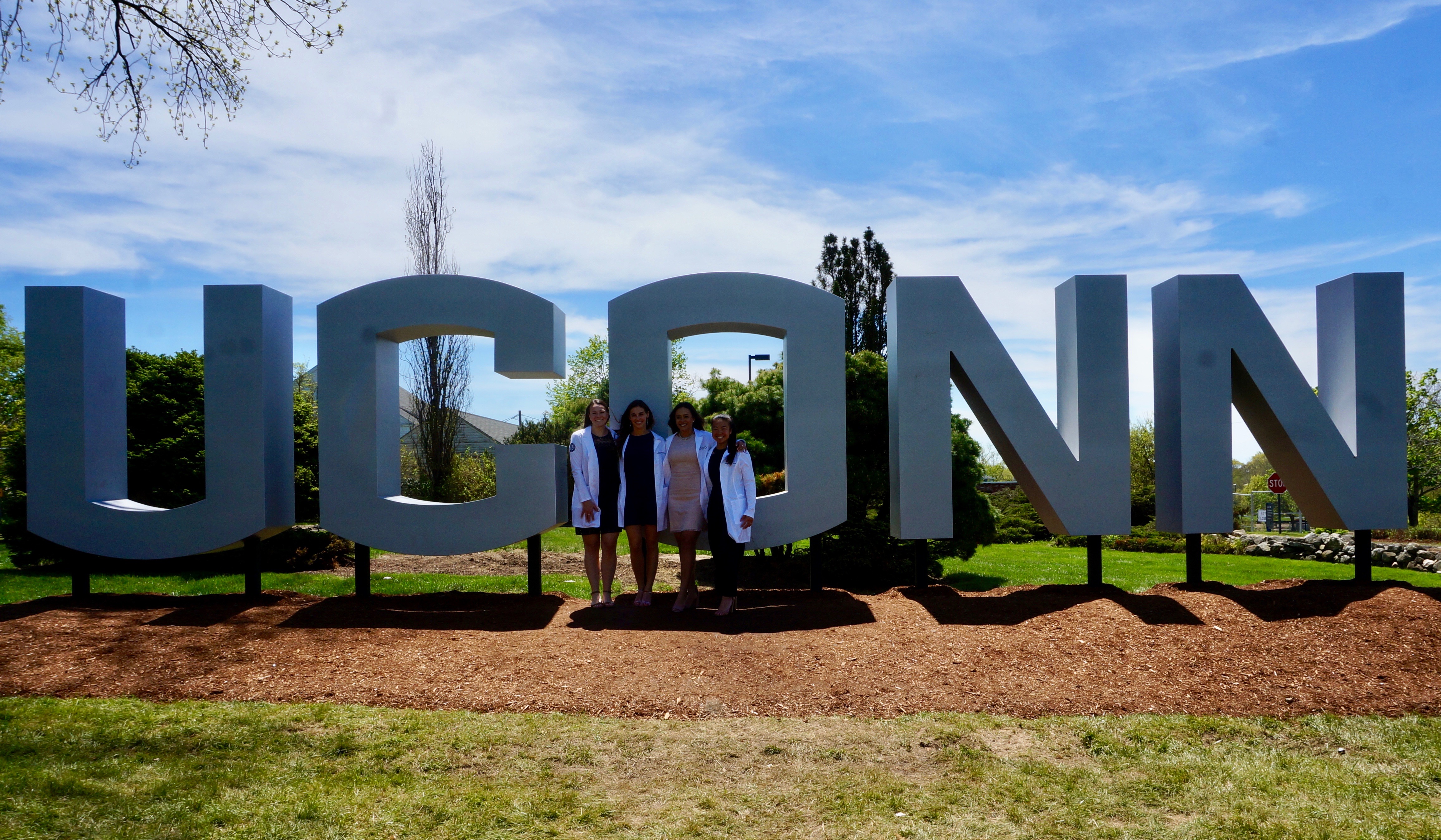Cost to Attend UConn Rises 23.3% over Next Five Years under New Tuition Plan

Audio By Carbonatix

The new sign on 195 UConn Storrs has become a popular spot for graduation and other celebration photos. Photo credit: Ronni Newton
In the first year of the proposed new five-year plan, tuition would increase by $608 for all students.
By Kathleen Megan, CTMirror.org
The cost for in-state students to attend UConn would increase by 23.3% over the next five years under a schedule of tuition increases announced Thursday by the university.
That percentage increase, however, is smaller than the 31% increase that students paid during the previous four-year schedule of increases. University officials said the new five-year plan limits year-to-year tuition increases to their lowest levels in five years.
The board of trustees is expected to vote on the proposal at its meeting next Wednesday and the plan will be presented to students at meetings today.
UConn President Thomas C. Katsouleas said that he asked Gov. Ned Lamont and legislative leaders to make every effort to hold state funding steady for UConn.
“That happened for the current fiscal year, and I am hopeful it can continue,” Katsouleas said. “As a result, we are able to propose tuition increases that are significantly lower than those enacted in recent years. This reflects the importance of the social contract between the state, its citizens and UConn as Connecticut’s flagship public university.”
At his inauguration in October, Katsouleas announced the Connecticut Commitment program to enable students whose families have an annual income of $50,000 or less to attend UConn tuition-free starting in the fall of 2020. The program will be limited to entering freshmen and transfer students.
A statement from the university said that the free tuition plan did not drive up costs for other students, noting that “the tuition plan would be the same even if that financial aid program had not been enacted.”
The tuition increase plan provoked strong criticism from Senate Republican Leader Len Fasano, R-North Haven.
“Yet again UConn, an institution that has long mismanaged its money, is asking for more from students. At the same time they are hiring more faculty and promising free tuition, they are raising tuition costs again on everyone,” Fasano said. “I believe making college more affordable and therefore more accessible to all students is a commendable goal. But clearly that’s not what UConn is doing. They are making new promises without a plan to pay for them. And tuition will increase yet again.”
He added, “I”m still waiting to see the UConn Foundation step up to raise funds to pay for the school’s transition to the Big East. It’s frustrating that UConn is becoming more and more difficult for young people to afford as new promises continue to be made.”
Sen. Will Haskell, co-chairman of the legislature’s higher education committee and a Democrat from Westport, was more sanguine in his assessment of the plan.
“While it is encouraging to hear that these will be the lowest increases over the past five years, it’s important to remember that reductions in state funding have put UConn into the regrettable position of shifting increasing costs to students,” Haskell said.
He said it is “incumbent on the Board of Trustees and General Assembly to ensure that adequate funding for our flagship university does not come at the expense of our student population.”
Rep. Gregg Haddad, who is the other co-chairman of the higher education committee and a Democrat from Mansfield, said he’s always hopeful that the university might be able to get away without any increase in tuition.
“But in this day and age of diminishing state support and increased expenses due to unfunded pension liability, it’s not unusual to expect that there would be some tuition adjustment,” he said, adding that it’s not as large an increase as he had expected.
Under the previous tuition plan adopted in 2015, in-state tuition increased at UConn by $950 in the current year of 2019-20, and by $1,250 for out-of-state students.
In the first year of the proposed new five-year plan, tuition would increase by $608 for all students. In the following years, it would increase by $625 in 2021; by $642 in 2022; by $660 in 2023; and by $679 in 2024.
In-state tuition is currently $13,798, while out-of-state tuition is $36,466.
While the dollar increase for out-of-state students will be the same as it is for in-state students, the percentage will be much smaller – at 11.3% over the next five-year period – because their tuition is already much higher.
The cost of attending UConn also includes room and board, in addition to tuition, for most students. The full cost to attend the UConn Storrs campus in 2020-21 would be $31,092 for in-state students and $53,760 for out-of-state students if this plan is approved and state aid remains level.
Those figures include the new tuition rate, along with mandatory fees and average room and board charges. Those costs are currently set at $3,428 in fees and $13,258 for average room and board, but these could change. The charges for room and board for the 2020-2021 school year will be determined in the spring of 2020.
The university said that, as required by state statute, the amount of money allocated to support financial aid will increase accordingly each year when tuition rates change to ensure adequate support for eligible students.
When institutionally-funded aid is factored in, the average in-state UConn student pays about $9,200 in annual tuition, the university said, with those who receive federal Pell Grants paying less.
“Access and affordability for our neediest students is a top priority,” said Nathan Fuerst, UConn’s vice president for enrollment planning and management. “Effective financial aid programs are critical to assisting our students in achieving their educational goals, and we anticipate adding to those programs further to continue drawing and retaining those students.”
UConn officials say the tuition proposal reflects the smallest possible increase necessary to protect the academic gains made over the years.
A statement from the university said it will also continue to reduce costs through consolidations, operational efficiencies and other measures that all will be vetted to ensure they do not compromise UConn’s academic quality.
“While much has been accomplished to date, the mandated costs ahead of us and our commitment to limiting tuition increases will require us to continue to aggressively manage our budget by cutting costs and finding efficiencies,” said Scott Jordan, UConn’s executive vice president for administration and chief financial officer. “It’s critical that the full burden of meeting increased costs doesn’t fall on our students.”
The university provided a breakdown on the components of the $608 tuition increase for next fall, saying that $100 of that figure covers cost increases, including personnel expenditures, while $389 accounts for inflationary increases. In addition, $119 was added to offset the increased fringe benefit costs that UConn is paying as part of the state’s plan to catch up with unfunded pension and retiree healthcare liabilities statewide.
University officials noted that, as with UConn’s two previous multi-year tuition plans, the university may recommend to the board that tuition rates be revisited if there is a significant drop in UConn’s state appropriation or a significant increase in costs.
The university said in a statement that the tuition proposal purposely used dollar amounts to increase the rates each year, rather than percentages, to avoid “enacting a disproportionately high increase on out-of-state and international students that would put it at a competitive disadvantage to draw highly talented students from other regions.”
“Because out-of-state tuition is significantly higher than in-state rates, percentage increases that have compounded over time have placed UConn as second only to the University of Vermont among public university competitors in the rates charged to non-resident students.”
Connecticut students comprise about 80% of the student body, the university said, adding, “but UConn also needs to attract talented non-residents, as the number of high school graduates in Connecticut is shrinking.”
The university said that without non-residents attending UConn, the in-state tuition rate would have to increase by 56% to uphold current academic standards.
Reprinted with permission of The Connecticut Mirror. The author can be reached at [email protected].
Like what you see here? Click here to subscribe to We-Ha’s newsletter so you’ll always be in the know about what’s happening in West Hartford!




Wow. So funny. We stick it to our own in state students. Look at what in-state tuition costs are in other states. I’m glad we had to buy two big houses for the new President. It’s only money. And now we have to pay to get back into the Big East? Oh that’s right, $10,000,000 to leave the AAC and $3,500,000 to join the Big East so $13,500,000. So, if you took out the two houses and this cost, how much would the tuition increase be? With the new increase, a student will spend $124,000 for a UCONN degree? That’s a lot of money. When I attended many years ago, I was able to work Summers, etc. I graduated nearly debt free. Are you listening Democrats? You run the state.